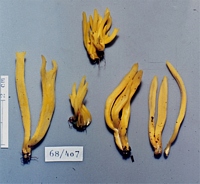|
 Ramariopsis ovispora Ramariopsis ovispora
BiostatusPresent in region - Indigenous. Endemic
Images (click to enlarge)
Caption: 68-407, id. R. Petersen, scale=20mm, NZ, SSI, Puponga, Farewell Spit, among litter under Leptospermum
scoparium, 09.05.1968, leg. EH
Owner: E. Horak |
Article: Petersen, R.H. (1988). The clavarioid fungi of New Zealand. New Zealand Department of Scientific and Industrial Research, Bulletin 236: 170 pp. Wellington:.
Description: Fruit bodies up to 80 x 7 mm, simple clubs, broadly fusiform, usually flattened and often sulcate, fasciculate in groups of up to 7 individuals, when young brilliant orange ("cadmium-orange"), fading slightly, egg-yolk yellow to golden yellow ("orange", "deep chrome") all over, with the stipe often somewhat brighter than club, fleshy, occasionally bifurcate apically, and then the branches divergent-ascending, cornute; flesh whitish inward, concolourous to hymenium outward. Stipe up to 4 mm thick, more or less terete, not well marked from club, arising from multiple primordium below substrate level. Taste and odour negligible.
Macrochemical reaction: FCL = dingy slate-green. Tramal hyphae of club 2-8 Erin diam., hyaline, clamped, relatively uninflated, free, more or less parallel, loosely packed. Subhymenium rudimentary. Hymenium thickening; basidia 70-100 x 8-10 gm, narrowly clavate, stiff when developing, collapsing after spore discharge, clamped; contents obscurely refringent to multiguttulate at maturity; sterigmata 4, stout, divergent.
Spores 6.1-7.2 x 5.0-6.1 Erin (E =1.13-1.33; E'° =1.22; L'" = 6.73 gm), broadly ovate to subtriangular in profile, smooth, thin-walled, hyaline; contents obscurely refringent when mature; hilar appendixvery stout, up to 2 gm long, conical; nucleus 1.
Notes: If this taxon had globose spores, it would be extremely similar to Ramariopsis fusiformis (Sow.: Fr.) Pet. Fruit bodies of the five specimens I have seen are surely so. Nevertheless, basidiospores are not globose, but tend towards ovate or subtriangular, not unlike those of R. depokensis (q.v.).
|